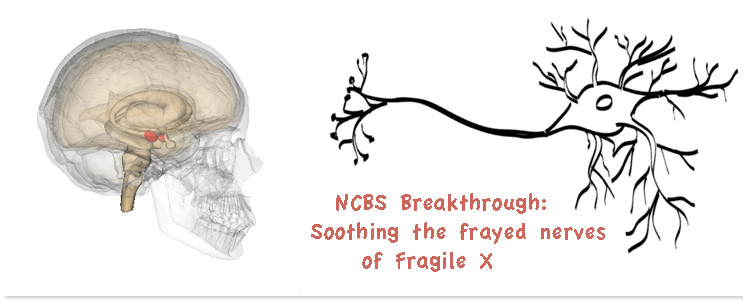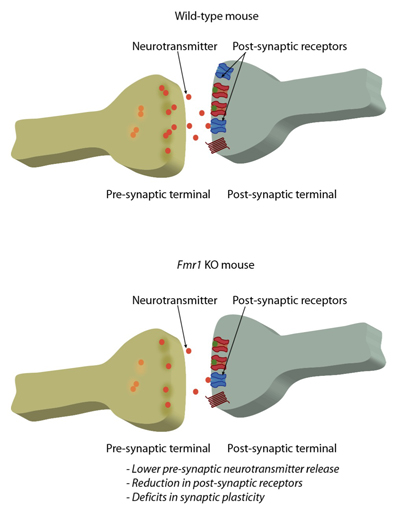NCBS breakthrough: soothing the frayed nerves of Fragile X

The amygdala is shown in red in the see-through brain. Image courtesy of Anatomography (Life Sciences Databases). Neuron cartoon: Aparna Suvrathan. Design: Geoff Hyde
A team of neuroscientists, led by Prof. Sumantra Chattarji at the National Centre for Biological Sciences, Bangalore has identified previously unrecognised synaptic defects in an area of the brain that is involved in the debilitating emotional symptoms of Fragile X Syndrome (FXS), the leading genetic cause of autism and mental retardation. The study is of potential therapeutic significance because it also shows that even a relatively brief pharmacological treatment is capable of correcting some of these defects in mice that were genetically engineered to model FXS. The work, done together with collaborators at New York University, will be reported in the online early edition of the Proceedings of the National Academy of Sciences the week of June 7-11.
Individuals with FXS, which is caused by a mutation in a gene on the X chromosome, suffer from a wide range of problems, such as learning disabilities, attention deficit, seizures, anxiety and mood instability, probably involving several regions of the brain. Currently there is no effective treatment for FXS and other types of autism, but helpful clues about potential drug therapy were provided by previous work that found defects in neurotransmission in the hippocampus, a region important for learning and long-term memory. These defects involve abnormal chemical signaling across the synapse - the junction between neighbouring nerves. Prof. Chattarji’s group focuses on the amygdala, a small, almond-shaped area long known as the brain’s emotional hub.
When they began to compare the nature of the defects in the amygdala with those of the hippocampus, Prof. Chattarji and his colleagues were actually worried. Their initial findings raised some concerns about the practicality of drugs that are currently being considered for trials to help alleviate the symptoms of Fragile X. These drugs, called mGluR blockers, are of interest because they promise to reverse the main defect in the Fragile X hippocampus: excessive signaling through the mGluR synaptic receptor. During synaptic signaling in the hippocampus, glutamate is released from one neuron and activates specialized receptor molecules in the next neuron. While there are different types of glutamate receptors present at the synapse, abnormally high signaling through one particular class – the group 1 metabotropic receptor (mGluR) – is implicated in many of the symptoms seen in FXS.

A summary of differences between features of mGluR signaling in the amygdala of wild-type mice (top), and of the mouse model of Fragile X (bottom). Cartoon: Aparna Suvrathan.
In the Fragile X amygdala model system however, Aparna Suvrathan, a graduate student in Prof. Chattarji’s lab, found that the neurons had signaling and physiological features that were at odds with the understanding of the mGluR system that had come out of hippocampal studies. The molecular aspects of these findings were confirmed and enriched by further analysis by NYU Professor Eric Klann and colleagues. Further concern arose when Aparna applied an mGluR blocker to the amgydala, because she did not see the effects that had been reported in previous hippocampal studies. The team was worried the drug might have no effect on defects in the amygdala and the emotional problems they cause.
But their final experiments with the Fragile X amygdala model ended up replacing their concerns with enthusiasm. They found a synaptic defect that had not yet been identified before either in the amygdala or hippocampus: the amount of glutamate released into the synapse was below normal. Most importantly, this defect could be rescued by the mGluR blocker, which boosted the likelihood of glutamate being released into the synapse. Overall they believe that their findings indicate that the mGluR blockers now being prepared by pharmaceutical companies such as Novartis and Roche should be even more broadly effective for Fragile X sufferers than previously thought.
The team does not yet understand why mGluR and its blockers can have such varying effects in the two different brain regions. But for Prof. Chattarji, who has been studying the amygdala for 10 years, the contrariness of the results is not completely unexpected. In earlier research from his lab, the team found that in other psychiatric disorders related to stress - such as anxiety and depression - the physiology and anatomy of the amygydala and the hippocampus change in opposite directions. He believes it may point to a fundamental tussle between two intrinsically different responses - cognitive processes mediated by the hippocampus versus emotional reactions under the rule of the amygdala. “In stressful situations”, says Prof. Chattarji, “ our emotions often veto our rational thoughts. The brain seems to have developed a way of making sure that when an organism is faced with a threat to its survival, the amygdala dominates. In Fragile X too we see this asymmetry where fear and anxiety dominate while cognitive function declines - reflecting profound changes in brain function caused by a single genetic mutation. But maybe soon we will have a way of pulling things back into line.”
This study was supported by grants from the FRAXA Research Foundation, Pfizer Asia R&D Collaborative Grant, and NCBS.

Comments
I believe your research is
Hello sir, Congratulations
Dear Sir Please help me by
Post new comment